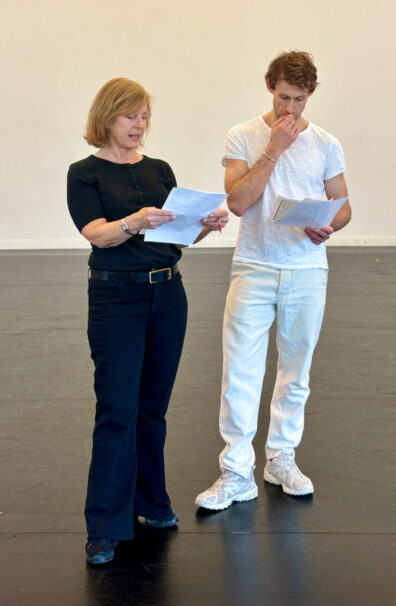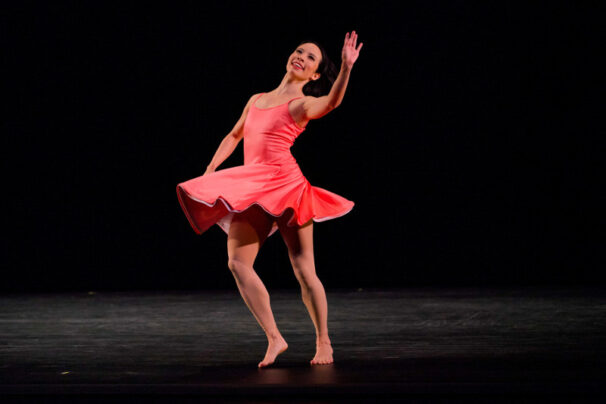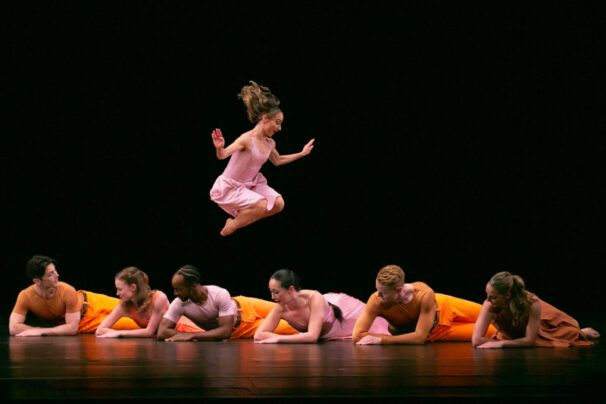It has become a celebrated and notorious moment in modern dance history: Paul Taylor’s Seven New Dances, the evening of purposely un-dancey pieces that inspired the now-famous blank newspaper review by Louis Horst. On May 13, reconstructions of works from that evening will take the stage of Kaufmann Concert Hall at the 92nd Street Y, where the now-legendary event took place.
In 1957, the young Taylor, then a member of Martha Graham’s company who had begun presenting his own choreography around New York, spent eight months planning and rehearsing a full evening of dances in which he questioned all his ideas and influences. Evaluating his previous works, he found himself questioning their intent, structure and impact. As he wrote in his 1987 autobiography Private Domain, Taylor began to pose fundamental questions about his art form. “What was a dance in the first place? Could it be anything? I made the decision to start over from scratch.” But in doing so, he wrote, “Some kind of building blocks were needed.”
The May 13 program (which will be live-streamed) will offer reconstructions of five of the seven dances, four in excerpted form, performed by the Paul Taylor Dance Company as well as several dance luminaries. 92NY, as it’s now known, has been celebrating its impressive history as a modern dance venue during this 150th anniversary year. When its board chair (and longtime Taylor supporter) Jody Arnhold approached Michael Novak, PTDC’s artistic director, about shaping an evening for 92NY, he considered not only how to bring portions of Taylor’s historic evening back to the Y, but about how to present it in a larger context.
“The idea that so-called ‘pedestrian movement’ – walking, standing, sitting, reaching – can tell stories and have visual impact is something that never really left Paul,” said Novak in a recent interview. “Even though Seven New Dances was never performed again, those ideas stayed within the repertory his entire life.”

Although the 1957 program was never repeated, the Taylor archives held a few clues from which Novak, rehearsal director Cathy McCann and the dancers could work. Some fragmentary film footage does exist: of Epic, Taylor’s opening solo (set to the insistent sound of what he described as “the phone lady who announces the time every ten seconds”) and Events II. “We do have Paul’s notebooks,” Novak explained, “so I went through those to assess how legible they were. There are photos – not many. It’s like a treasure map, with little clues along the way.
“There’s something exhilarating about walking into a room with dancers {and saying] here are Paul’s notes, blown up on an 11 x 17 sheet of paper. This is all we have! Let’s collaborate and figure out what this is. We have this one photo; it shows we-don’t-know-what moment, but let’s figure it out. How do we piece this together? It’s very collaborative. It requires a great deal of math—and fortitude.”
Cathy McCann added, “Paul’s written notes, which sometimes included counts, were also found. These counts might refer to the pulse of a recorded heartbeat or an internal pulse felt by the performer. In addition, I was given drawings of stick figure poses and postures that he was exploring. Studying those, written in his small yet detailed handwriting, was very helpful and, for me, quite moving. It showed me his deliberate and thoughtful exploration of the question, ‘What is dance?’”
Duet, a section of the evening that particularly tried the 1957 audience’s patience, offered what Taylor described as “nothingness taken to its ultimate.” The company had Taylor’s detailed notes for that, which included diagrams. “In his notes, Paul writes: ‘to be performed beautifully. Try not to blink,’” said Novak. It will be performed by two stellar former dancers Damian Woetzel, president of the Juilliard School, and Alicia Graf Mack, director of its Dance Division.

Two of the sections to be presented, Panorama and Opportunity, have never been danced since 1957. Epic, which was revived during Taylor’s lifetime and performed by Elie Chaib, on Monday, will be danced by NYCB principal Adrian Danchig-Waring.
In his investigation leading to these stripped-down works, Taylor observed his fellow urbanites’ activities and behavior. “Their moves and stillnesses are ABCs that if given a proper format could define dance in a new way.” While much of his 1957 audience made a disgruntled early exit, Taylor went on to incorporate the essence of his research into more mature, multifaceted works.
Novak sees a clear throughline from Taylor’s radical 1957 project to Esplanade, his landmark 1975 work that has never left the repertory and will close the May 13 program. “Can we connect 1957 to Esplanade?” Novak pondered. When he designed a 2022 program of very early Taylor works for a Joyce Theater run, Novak included an initial reconstruction of Events, a female duet set to the sound of falling rain that was a section of Seven New Dances. Hewas struck by how it resonated. “I thought it was mesmerizing and extraordinarily beautiful, but I couldn’t help seeing the emergence—a hinting—of Esplanade, particularly its second section.”
The program will open with a glimpse of the company’s future: excerpts from three works that resident choreographer Lauren Lovette is currently creating. And it will be framed and narrated by the eminent actor Alan Cumming, who, Novak reveals, knew Taylor well and even took class at the Taylor School. He will read from the relevant chapter of Taylor’s eloquent autobiography.
“Paul’s voice is so idiosyncratic, witty and sarcastic,” said Novak. “There are so many layers. I thought, what if we had a narrator, and we took this chapter and turned it into a script? So Alan will be our guide.”
Paul Taylor Dance Company | 92nd Street Y | May 13
Susan Reiter covers dance for TDF Stages and contributes regularly to the Los Angeles Times, Playbill, Dance Australia and other publications.



